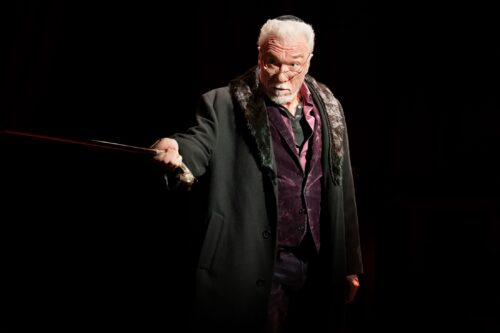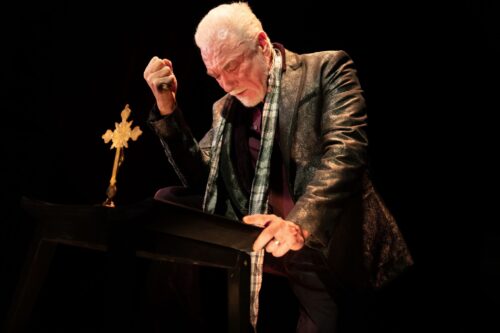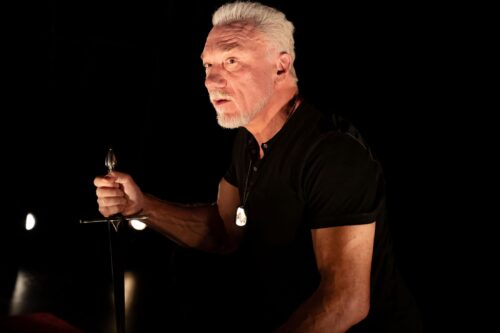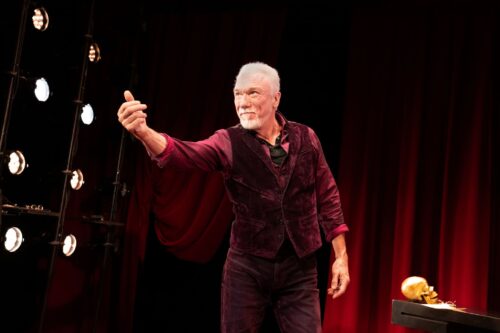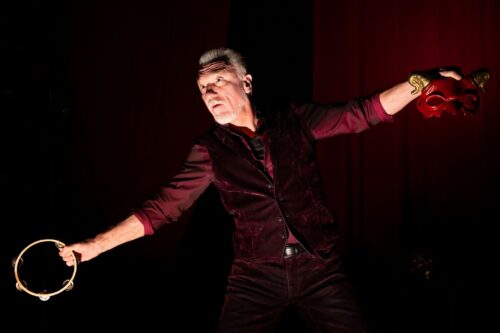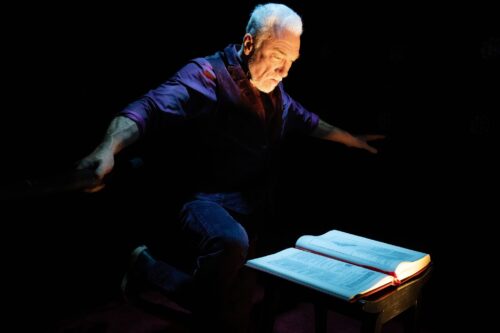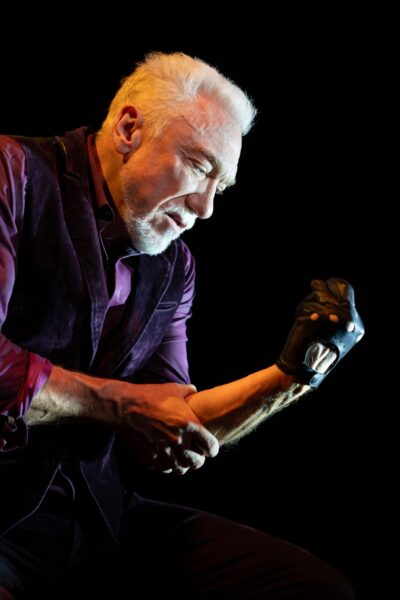WICKED GOOD THEATER
Patrick Page was exposed to Shakespeare as a toddler in the mid-sixties; since then he seems to have been deeply feeling, researching, analyzing and performing every word the Bard wrote. All the Devils Are Here: How Shakespeare Invented the Villain, his solo show at the DR2 Theater, written by him and directed by Simon Godwin, is an acting masterpiece. Page takes us on a chronological journey through Shakespeare’s dark side in a passionate and playful way, while gifting us with a master class by a virtuoso. Neither didactic nor too melodramatic, this play is a must-see.
Commanding attention in a way that’s rarely experienced, he starts as Lady Macbeth calling upon the spirits, whispering with a broken voice “Come, you spirits … and fill me from the crown to the toe top-full of dire cruelty.” Can you think of a more effective way to welcome evil on stage? When the lights come back up we find our teacher, our spirited guide. Page introduces us to the Vice, a buffoonish devil-like character common in all cultures. Young Shakespeare loved the Vice role and used it in all its facets starting from copying the role of Barabas in Christopher Marlowe’s The Jew of Malta for his Aaron the Moor in Titus Andronicus, both morally reprehensible characters. To show us how similar the two roles are, Page — who knows a thing or two from playing the devil in Hadestown — delivers two monologues, back to back, where they recount horrifying deeds they had committed, not for the faint of heart.
He then effortlessly moves from role to role, standing or sitting, with minimal costume change. We get to Richard III and his tragic flaws; Page truly makes us feel his grim condition, the hatred he sensed from people, and revenge as his only solution. Was he destined to be evil? A little juicy gossip on the Bard, followed by a sudden movement, a change of light, and we are with Shylock in The Merchant of Venice. He demands a pound of flesh and at the same time reminds his oppressors that we are all part of the human family. His motivations are clear but did he become evil because he was persecuted or was it innate like the Vice, Page asks in a voice so mellifluously and devilishly husky that it shudders through your soul.
Too dark for you? Enter Malvolio, from Twelfth Night, a comic villain, the arrogant, self-important, disagreeable, authoritarian steward of Olivia’s household. He is a social-climber, a no-no in Elizabethan times, and he ends up being publicly humiliated for it. Page makes us feel sorry for him with his delightfully frivolous interpretation. Right back to the darkness with Hamlet’s murderous uncle, King Claudius, who killed his brother and whose offence “smells to heaven.” And, with disgusting Angelo, the deputy to the Duke of Vienna from Measure for Measure, who demands Isabella’s virginity in exchange for her brother’s life. “Who will believe thee…,” Page utters making us shiver. We go deeper into the psyche of evil with master manipulators, welcoming Iago to the mix. Page gives us the psychopath who, differently from the gruesome devils, using only a lie repeated over and over, poisons Othello’s mind and causes a murder-suicide.
Edmund, another manipulator, the illegitimate son of the Earl of Gloucester in King Lear, has a different motivation for his revenge – “Now, gods, stand up for bastards!” He kills his brother and father to become Earl. And, finally, the “Scottish play,” Page says, “a play so steeped in evil that most actors won’t dare to speak its name.” Saying the play’s name aloud in a theatre causes bad luck. What can we do? Page shows us how to break the spell: turn three times, spit and swear. His commentary is insightful and, at the same time, hilarious, but we are at the pit of the Inferno. Re-enter Lady Macbeth, the anti-mother, the master-manipulator, the psychopath. Not as much as Iago but darker. To take us back “to see the stars,” Page lands us on Ariel and Prospero, a way to Purgatory. “Hell is empty, and all the devils are here,” is a line from The Tempest. In the end, where is evil, how do we find it? Page puts a hand on his heart. Lights out.
The design team includes Arnulfo Maldonado (Scenic Design), Emily Rebholz (Costume Design), Stacey Derosier (Lighting Design), and Darron L West (Sound Design).
photos by Julieta Cervantes
All the Devils Are Here: How Shakespeare Invented the Villain
DR2, 103 E 15th Street
ends on January 29, 2024 EXTENDED to March 31, 2024
for tickets, visit at All the Devils Play or Telecharge


